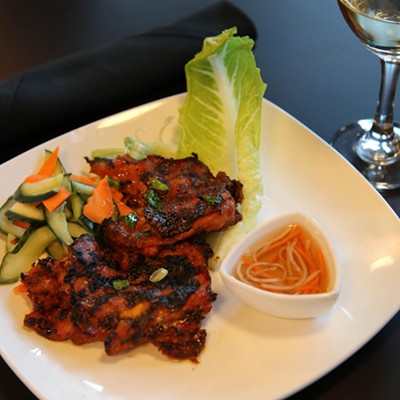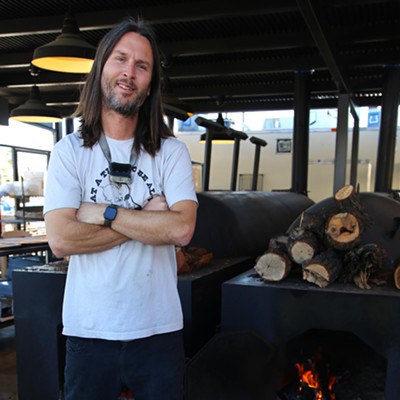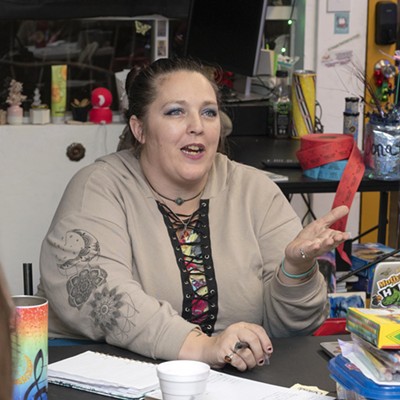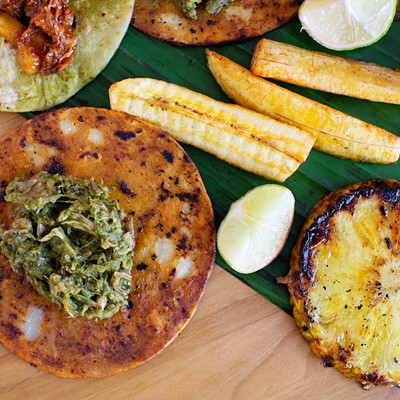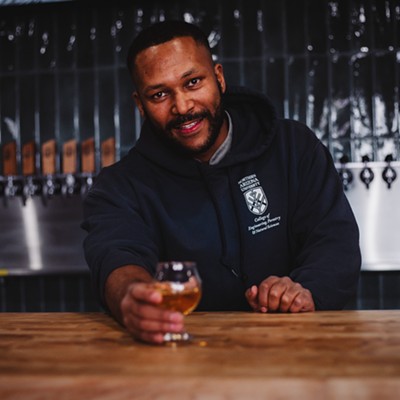My Tack Room memory chip includes images of the big concrete cowboy boot on Sabino, marking the entrance; the low ranch-style hacienda dining room; a wondrous display of wines; the kind of ornately bound and voluminous menu which has mostly disappeared in our post-Atkins world; and a table setting that almost required the Junior Assembly training with which I'd been blessed/cursed.
But most of all, there was Charles Kerr. Gracious, looming, impeccably befitted in suit and tie, thoroughly in command and totally at service, Charles was for years so much more than the maitre d' at the Tack Room. He was the very definition of all that a restaurateur could possibly be: director, set designer, choreographer, master of ceremonies, ultimate ombudsman.
Flash forward perhaps a decade: I come back from a summer of theater in Connecticut to find a special invitation to a preview of a new restaurant about to open. "Charles," created in the old Pond mansion which is now the Mountain Oyster Club (east, off Wilmot Road, though I am tempted to say if you need to ask "where," you shouldn't be going--yeah, it's THAT sorta place), would open after Labor Day, and I was invited to tour and sample. How special an invitation it was, I came to realize on the appointed night when there were only two guests--Tom Brown, of Burr-Brown, and li'l ol' me--and a full front- and back-of-the-house staff. Charles, never a shy type, wanted to show off what he and his better half, Katherine, had brought into being with the backing of some very generous investors. He lined the staff up--from hostess to waiter to busboy to chef to dishwasher--and went right down the line asking questions and answering questions. He then sent them off to do their job: serving his two guests that night.
Sound a little ... hmmm ... focused, if not weird? Here's the best part: We didn't order; Charles had determined our dinner for the night. And for mine, he'd prepared exactly the meal I'd had with my prom date 10 years before! Jumbo fresh shrimp, a Caesar salad made tableside (and using raw eggs, thank you very much), sautéed spinach with garlic, a golden-crusted Chateaubriand, potatoes diane, bananas foster for dessert. He remembered it! He had the most prodigious memory of anyone I have ever known.
Charles' future was never so luminous as it was in those days, and when he passed, we lost a great, if complex and sometimes difficult, mind. In later years, as a waiter at the Palomino, he was older but equally dexterous in memory and spirit. I've been privileged to know some great waiters and restaurateurs, and I like a great many others besides, but Charles Kerr was rara avis--the kind of host who knew what you wanted before you expressed it and had it ready when you needed it ... a vanishing breed.
Now, flash forward several decades and meet OpenTable.com, a software-package-cum-management-and-customer-service tool that is surprisingly captivating. I was introduced to it last week by Maya and Michael Luria of Terra Cotta, and while it will never quite replace the amazing humanity of a Charles Kerr, it promises a bright and comfortable future for those of us who value feeling at home in our restaurants.
OpenTable.com has, fundamentally, three parts to it: online reservations, database management and table maintenance. Participating member restaurants are featured on its Web site (Tucson has nine, Phoenix 38, and the system is nationwide and operates, at this point, in Puerto Rico, the Virgin Islands and six other countries as well), and by logging on, you can make reservations through it. And, more than reservations--you can request a particular location, indicate if it's a special event and note a variety of things. Michael Luria says that the service is adding roughly 300 new restaurants a month to its participating base. Terra Cotta has been affiliated with it for less than a month, and he is an enthusiast.
"Eighty percent of my decision (to participate) had to do with database richness. ... I'd have hooked up with it even if there hadn't been the online stuff," he said the other day. But the online "stuff" is good news, so far: In the past two weeks, he estimates there have been at least 60 reservations made through it. It costs Terra Cotta $1 for every reservation booked through OpenTable.com--compared to the 25 cents it costs them if you book through Terra Cotta's link, DineTerraCotta.com--but business is business.
And the table maintenance piece is sweet, too. It lets the terminal user know if a table is available and ready, who is there, who the server is, whether the check has been presented or not and if it's been paid, and if the table is ready to be turned over. You touch the table icon on the screen, and a regular client--and his or her history--can pop up, providing a wealth of immediate information. Aside from the "active" use, its planning potential is terrific beyond the relatively simple matter of table disposition.
"From daily/weekly/monthly reports, I can see how many are reservations, how many are walk-ins, no-shows, or canceled reservations. It helps me look for the trends: It might tell me that a third of our biz is walk-ins, for example," said Luria. "Friday nights might be great on walk-ins, and Saturdays solid for reservations--and that helps me to schedule for staffing." Be warned: If you make reservations though OpenTable.com and are a no-show three times, you get booted from the system.
OK, OK. It's a great tool for restaurant management, from advance reservations to staffing, but what does it do for us--the clients? Plenty, it seems.
"When you make reservations, you have to log in and create a profile. You get points for every reservation you make and keep. You can redeem those points for credit," explains Luria. "You can tell us whatever it is you want to tell us: 'It's my anniversary, my birthday, our first time there, etc.' We can customize your experience."
And more. If, for example, you customarily drink Grey Goose and pineapple juice (I know, I know ... but I actually have friends who order that), it can be entered on your profile. Or the fact that you also tolerate Cîroc vodka or hate onions on your salad or fancy Cockburns' 20-year tawny port and won't ever take a coffee. You might be a vegetarian or particularly fond of soups, detest fish and love the crème brulée. Or maybe you like a particular server, had a previous problem with an underdone filet, are a "VIP" or a host of other things. It can all become part of your profile under the program's "customer notes" and "customer codes."
"It definitely requires the server and us to be on the ball," said Luria. "No restaurant really has the time to ask 20 questions, but over time, you build that database and begin to customize the experience for your guests. It's a win-win situation: The guest wins, and we win."
How much does this happiness cost? Well, for us, Dear Reader, nada. It's a gift of improved service. In Terra Cotta's case, it costs roughly $350 a month, depending on the number of smart terminals they have slaved to the OpenTable program, and, of course, the above-mentioned fee they pay for reservations through it or through their own Web site, which is tethered to it.
I have to confess that I love this idea. When I walk into Terra Cotta, do I want Garrett-the-server to smile and ask if I wish a dirty-and-dry Tanqueray with three Gorgonzola-stuffed olives to start out? And then tell me about an incredible soup? You betcha! Or suggest the porterhouse, because my profile has indicated I am a hopeless carnivore? Bring it on.
Charles, wherever he rests or plays, would be rolling his eyes, I am quite sure, at this evolution of personal-service possibilities. But this is a Big Brother of whom I can be fond--as I was of him. We move forward.


